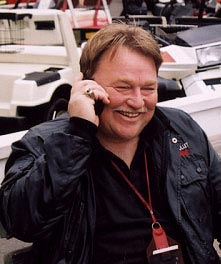
Let some of that prize money trickle on down
Nevertheless, there is no doubt that in general today there are fewer cars in the professional classes than there used to be. Even the Pro Stock class, which used to routinely attract 40 plus cars at NHRA events not so long ago, is delivering smaller fields. At this year's NHRA Winternationals there were just 22 entries in that class, 11 fewer than were entered for the same class last year. What got me thinking about this subject of car count or lack of cars is the Pro Mod class. Pro Mods have replaced Top Fuelers and Fuel Coupes as an affordable special attraction for local tracks. It's a class that will put butts on the boards at facilities where 5,000 spectators mean a full house. There are still Pro Mod races where you can see 50 or more cars trying for eight to 16 spots just like the good old days when a like amount of Top Fuel or Funny Cars showed up at local tracks around the country. The trick will be to keep that happening. Everybody is getting on the Pro Mod bandwagon. In the South, Pro Mod circuits and Pro Mod racing have been the promoter's friend for over a decade. These days they may be called "ten-wide" or "street legal" instead of Pro Mod, but they offer basically the same attraction: bad-fast door cars that race heads-up. Here in the Midwest (where the world headquarters for DRO is located)
heads-up doorslammer racing is exploding. Last year two Midwestern
tracks hosted about a dozen events for these cars. This year we
have at least four tracks scheduling about 50 races for Pro Mods,
not to mention the new ADRL six race series. Chassis builders and
engine builders can't keep up with the demand for cars and engines.
Then the class developed stars and those stars developed followings and egos, demanding and getting more appearance money because they had the money to build the fastest cars. Track owners and bookers decided that the fans were only coming out to see these stars. Eventually the tracks either had to pay those racers a premium or, knowing that the stars would usually win, pay the biggest part of the purse to the winner. As a result, the majority of the racers -- those that don't win and aren't stars -- got smaller and smaller paydays and eventually came to realize that it was costing them a big chunk of the mortgage money to go to the races even if they did qualify and go a round. Eventually and inevitably those cars ended up in the garage and the racers in the grandstands. So, what is the lesson to learn from this lecture? It is that stars simply aren't enough, you also need cars or there is no show. Putting a majority of the purse on top may attract the superstar and look good in the press release, but it doesn't always ensure a successful race. I suggest that promoters need to understand a couple of things. First, every racer worth a damn believes going in that they have a good chance to win that first-prize money, but only one will get that money and it is usually the same small group of racers. If you pay the winner ten times what the last qualifier gets, the last qualifier and non-qualifiers will eventually be forced to quit. That kind of purse only serves to make the star more dominant and makes it harder and harder for the supporting cast to keep coming back. Second, I've been going to all kinds of races for over 40 years and have never, ever seen a crowd hang around to see a winning driver get his check for six figures. Promoter, put yourself in the shoes of the racer, his family and
crew. If the check a racer gets for racing won't cover the fuel
bill much less any repairs to the race car or a nice dinner for
the team on the way home, wouldn't you start wondering why you keep
racing? I suggest that promoters who depend on non-professional racers (just putting the letters PRO on the windshield doesn't make you a professional racer, guys) to support the special events will help bring in more racers by spreading the wealth around. They'll still develop heroes that will attract crowds and if those heroes want to go race for the big money at the big circus let them, chances are good they'll be back. Local promoters should try to make racing in a local circuit if not affordable, at least not wallet-busting. Putting up big money to win often results in some "touring pro" showing up, beating up on the locals and then leaving the promoters with a bunch of pissed-off racers. I won't try to speak for anyone except myself, but given the choice between buying a ticket to watch 25-30 200-mph, six-second "unknown" Pro Mod racers trying for 16 spots at a race that pays $3,500 to win and $1,000 to qualify or watching eight "hitters" racing for $25,000 winner take all, I'll always buy a ticket to watch the 25-30 car show. I've finally come to the realization that Wally Parks had it right
from the start. As a drag racing spectator I do care about who is
driving the cars, but what really grabs my attention and what I
pay to see is fast cars and plenty of them. The only time I really
get interested in who is driving the car is when they get out at
the end of the track and start a fist fight. |
|||||||||||||||||||||||||||||||||||||||||||||


 Almost
every time a bunch of old nitro-geezers -- the Burkster included
-- get together and start sloshing down adult beverages and talking
about the "good old days," inevitably the discussion comes
around to when 100 Top Fuel cars showed up for this race or 50 floppers
at that race. I personally never saw a race with that many cars,
in fact, the most Top Fuel cars I ever saw at a race was back in
the late '70s when NHRA still had 32-car Top Fuel fields at the
U.S. Nationals.
Almost
every time a bunch of old nitro-geezers -- the Burkster included
-- get together and start sloshing down adult beverages and talking
about the "good old days," inevitably the discussion comes
around to when 100 Top Fuel cars showed up for this race or 50 floppers
at that race. I personally never saw a race with that many cars,
in fact, the most Top Fuel cars I ever saw at a race was back in
the late '70s when NHRA still had 32-car Top Fuel fields at the
U.S. Nationals. 
